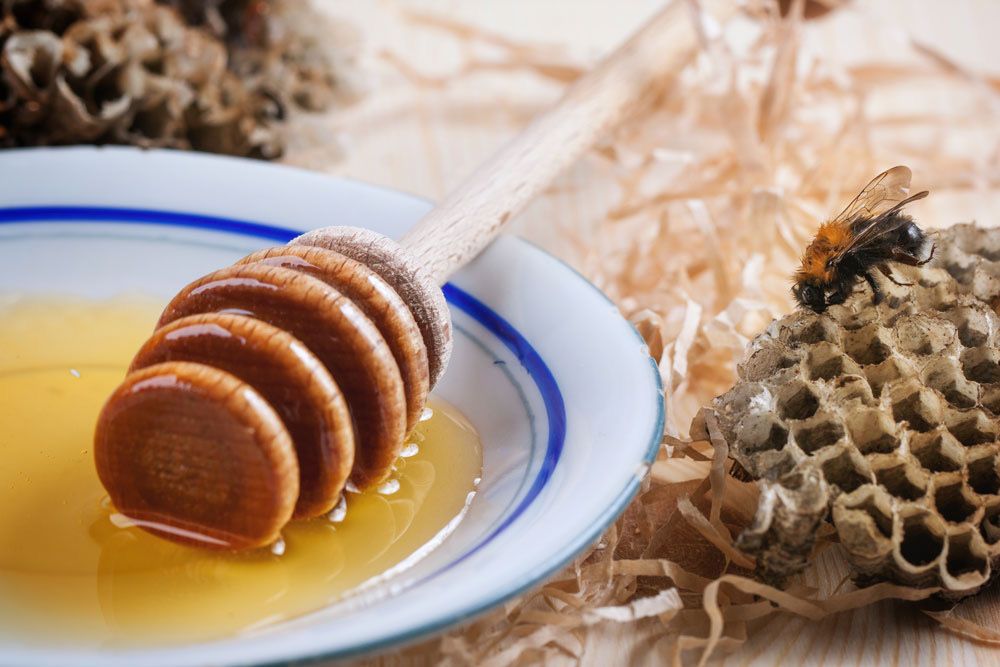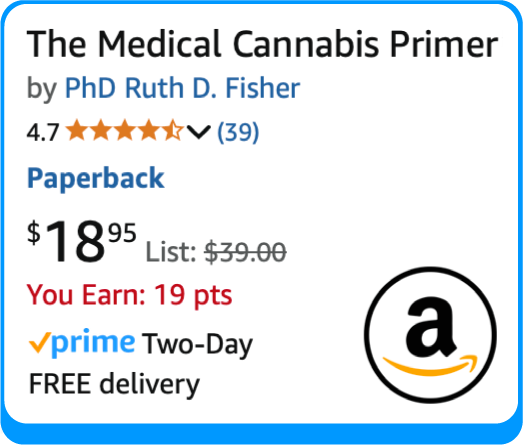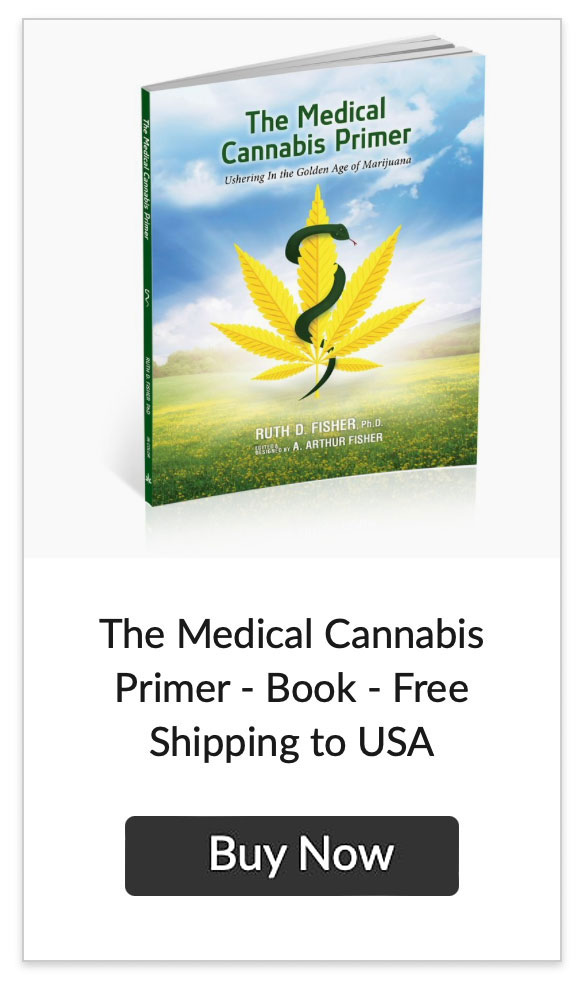Blogs
The Mysteries of Cannabis Honey
Ruth Fisher

The cannabis world is all a buzz about cannabis honey. The talk is not about taking honey and infusing it with cannabis, but rather feeding cannabis to bees and having the bees incorporate cannabis into the honey they make. It’s bee-made cannabis honey, not man-made.
The reason for the buzz is that bee-made cannabis honey has a much faster onset – “five to ten minutes compared with thirty to ninety” – together with “100 times the efficacy of cannabis-infused [i.e., man-made] honey.”[1] So it’s not the honey that’s making the cannabis more bioavailable; it’s something else.
What, exactly, are bees doing to the cannabis to make it so much more accommodating for medical cannabis use?!
This analysis seeks to answer two questions:
- How do bees process cannabis?
- How is bee-processed cannabis incorporated into honey?
Bees and Cannabis
Let’s start by examining the role bees play in cannabis cultivation.
What we know about cannabis pollination
Cannabis is a dioecious plants, which means that females only produce seeds when their flowers are fertilized by pollen from male plants. For pollination to occur, pollen must travel from the flowers of male plants to the flowers of female plants. There are two ways plants have evolved to transport male pollen to female flowers: wind pollination or insect pollination.
In the case of wind pollination, plants rely on the wind to carry pollen through the air; bees are not needed for the plants to reproduce. In the case of insect pollination, on the other hand, in order to attract insect pollinators, plants have evolved to produce (i) nectar around the pollen, (ii) brightly colored flowers, and/or (iii) sweet floral aromas.[2] As insects feed on the nectar, nearby pollen becomes attached to their bodies and is transported with the insects as they travel to other flowers in search of nectar. Wind-pollinated crops, by their nature, rely on wind to carry their pollen and thus have not evolved to produce nectar.
So which type of pollination does cannabis rely on? Cannabis is wind-pollinated, and so it has not evolved to produce nectar, the primary ingredient in honey. Well, then, cannabis isn’t getting into bee-made honey through cannabis nectar, how is cannabis getting into the honey?
What studies show about bees and cannabis plants
Perhaps understanding the nature of bee interactions with cannabis plants will help solve the mystery. A couple of researchers have studied patterns of bee activity in areas where hemp crops were cultivated. The studies show[3] that bees are attracted to hemp plants
- That are male
- That are tall
- That flower later in the season than other plants.
Interestingly, bees do not like female cannabis plants. What do male cannabis plants have that female plants don’t? Pollen.
It also turns out that cannabis tends to flower later into the season than most other plants. There is more bee activity around male cannabis plants precisely when other plants do not have pollen or nectar available for bees to feed on.
The consensus thus seems to be that bees are attracted to cannabis for its pollen, not its nectar, but only as a last resort. That is, bees feed on cannabis after other crops have completed their blooming periods, when bees lack better alternative food sources than cannabis.
Nectar vs. Pollen
At this point, I’m a little confused about the difference between pollen and nectar, and how do bees use each in their activities. Let’s clear up the confusion.
According to a couple of Master Gardeners,[4] pollen is essentially plant sperm (the male reproductive component), while nectar is a sugary liquid produced by plants precisely to attract pollinators. Pollen is located around the nectar, so when insects come to feed on the nectar, they inadvertently pick up pollen and transport it to female flowers during their feeding activity.
As for nutritional value, “pollen contains protein, along with fat and other nutrients pollinators need while nectar contains sugars, vitamins, salts, oils, and additional nutrients that together offer a high energy food source for pollinators.” [5]
Bees use both pollen and nectar as sources of food. “Nectar is the main source of energy for bees, while pollen provides proteins, lipids, vitamins and minerals for brood rearing and development.”[6]
Cannabis Pollen
So far, we know that bees collect pollen from male cannabis plants to use as a source of food, and somehow cannabinoids end up in bee honey. The only way for this to happen is if cannabis pollen contains cannabinoids. Sure enough, it does. Cannabis pollen is “rich in cannabinoids.”[7] As an aside, pollen also contains flavonoids.
Bee Pollen
So far, we know bees are attracted to cannabis pollen as a source of food when more desirable sources of food are not available, and we know cannabis pollen contains cannabinoids. Somewhere along the lines, pollen is being processed by the bees and the cannabinoids in the pollen are ending up in honey. Let’s take a closer look at what’s happening during all this.
Bees collect pollen from male flowers, they mix it with nectar or saliva, and they pack it into little baskets attached to their hind legs. These stores are called pollen loads. The bees take the loads back to the hive, where they are unpacked by house bees, who continue to chew on the pollen and mix it with saliva. The result is bee bread. Bee bread is packed into honeycomb cells, covered with honey and sealed with wax. While the bee bread is stored in the honeycomb, it ferments. “Bee bread constitutes the basic protein source for the bee colony.”[8]
So, bees process cannabinoids by adding saliva (enzymes) to cannabinoid-rich pollen and letting the mixture ferment.
Bee bread contains fewer proteins than the original pollen, but they are easier to absorb. Specifically, “Bee bread is more easily digested than pollen loads.”
Bee bread also contains the following substances:
- proteins with essential amino acids
- vitamins C, B1, B2, E, H (biotin), K, P (rutin), nicotonic acid, folic acid and pantothenic acid
- pigments, carotenoids and anthocyanins
- the enzymes saccharase, amylase and phosphatase
- flavonoids
- more than 25 different minerals and spore elements such as iron, calcium, magnesium, phosphorus, potassium, copper, zinc and selenium. [9]
How Bees Make Honey
Now we know how the pollen is processed by bees to make bee bread. All that’s left is understanding how the bee bread gets into honey. So let’s see how bees make honey.
Bees gather nectar from flowers and store it in their stomachs for transport to the hive. At the hive, house bees unpack the nectar from forager bees and chew on it for about 30 minutes.
While chewing, she [the house bee] adds enzymes to the nectar to break it down, forming a simple syrup. The enzymes also reduce the water content in the nectar. This makes it easier to digest and less likely to be plagued by bacteria while stored inside the hive.[10]
After chewing on the nectar, house bees “spit up” the nectar and pack it into honeycomb cells. While packed in the cells, water continues to evaporate from the honey, making it thicker over time.
How Does Cannabis Get into the Honey?
Honey is made from nectar, not pollen. So then how does the pollen get into the honey?
We left the pollen as having been converted into bee bread and packed in honeycomb. It sounds like small amounts of the other substances also being used in the hive, including pollen, find their way into the honey. On the other hand, honey may contain more substantial amounts of pollen (and thus cannabinoids), if the comb containing bee bread is (inadvertently) collected by beekeepers along with comb containing honey:
Honey in the comb contains small amounts of pollen, wax, propolis and possibly also bee venom. The amount of these substances depends on how long the honey is left in the comb……However, crushed or pressed honey can contain a large amount of pollen. If there is a lot of bee bread in the comb, this honey is actually a combination of honey and pollen.[11]
A final note on pollen in the honey: raw organic honey generally contains some pollen, while “regular” honey does not. Regular honey tends to be filtered and pasteurized, during which time any pollen that may originally have been in the honey is removed.[12]
Discussion
Natural bee-made cannabis honey generally only contains trace amounts of cannabinoids, because the cannabinoids are coming from pollen that inadvertently makes its way into the honey.
There are several brands (e.g., CannaBeez, Nicholas Trainer-bees, CannaHoney) currently producing “cultivated” bee-made honey, which contains more cannabinoids than so-called natural bee-made honey. These companies are feeding bees a food stock containing sugar, cannabinoids, and other nutrients.[13] Presumably, these food stocks are being used as nectar to form the basis of the honey. So then, these products are engineered to contain more cannabinoids in general, as well as specific profiles of cannabinoids. Quite ingenious, if you ask me.
To summarize our findings, bees collect pollen, mix in bee saliva, and let the mixture ferment. The cannabinoids in the resulting substance are significantly more digestible — bioavailable — than normal. So it must be the enzymes in the bees saliva. Ilan Ben Simon, founder of PhtoPharma, maker of CannaBeez, came to the same conclusion: [14]
Ben Simon theorizes that something about the bees’ digestive process improves the bioavailability of the cannabinoids in the honey, but until the research is complete, he says, “to understand how fast this honey is, I think you just need to try it.”
Avner Ben Aharon, PhytoPharma’s CEO, provides more details:[15]
"There may be two optional mechanisms that can explain the honey’s high-efficacy," Ben Aharon continued. "The honey serves as a high-efficient vector to cross the Blood-Brain Barrier. While producing the honey, cannabinoids are transformed in the bees’ stomachs into superiorly efficient molecules."
So now you know what the buzz is all about!
References
[1] Somerset, S. (2018, Nov. 18). Artisanal Edible Cannabis Honey Causes A Buzz. Forbes. Retrieved from https://www.forbes.com/sites/sarabrittanysomerset/2018/11/19/artisanal-edible-cannabis-honey-causes-a-buzz/#45b4c50a718d
[2] Schmidt, S. (2016, Mar 23). Bees and Cannabis. Bee Culture. Retrieved from https://www.beeculture.com/bees-and-cannabis/
[3] Flicker, N.; Poveda, K. and Grab, H. (2019, Oct 29). The Bee Community of Cannabis sativa and Corresponding Effects of Landscape Composition. Environmental Entomology. C. O'Brien, H.S. Arathi (2019, Jan). Bee diversity and abundance on flowers of industrial hemp (Cannabis sativa L.). Biomass and Bioenergy.
[4] Touhey, P. (2019, May 30). Ask a local master gardener: What’s the difference between nectar and pollen? Daily Hampshire Gazette. Retrieved from https://www.gazettenet.com/Ask-a-local-master-gardener-What-s-the-difference-between-nectar-and-pollen-25855711. Williams, R. (2018, Mar 12). Pollen and Nectar, Not the Same. UC ANR. Retrieved from https://ucanr.edu/blogs/blogcore/postdetail.cfm?postnum=26573
[5] Touhey, P. (2019, May 30). Ask a local master gardener: What’s the difference between nectar and pollen? Daily Hampshire Gazette. Retrieved from https://www.gazettenet.com/Ask-a-local-master-gardener-What-s-the-difference-between-nectar-and-pollen-25855711
[6] Nicolson, S. (2011, Jun 28). Bee food: the chemistry and nutritional value of nectar, pollen and mixtures of the two. African Zoology. Retrieved from http://africanzoology.journals.ac.za
[7] M. Paris, F. Boucher, L. Cosson (1975, Jul – Sep.). The Constituents of Cannabis sativa Pollen. Economic Botany. Retrieved from http://www.jstor.org/stable/4253616
[8] Komosinska-Vassev . K. et al. (2015, Mar 9). Bee Pollen: Chemical Composition and Therapeutic Application. Evidence-Based Complementary and Alternative Medicine.
[9] Mutsaers, M. et al. (2005). Bee products: properties, processing and marketing. Agromisa Foundation. Retrieved from http://teca.fao.org/sites/default/files/resources/Agromisa-AD-42-E 1 beekeeping manual .pdf
[10] How Do Bees Make Honey? PerfectBee. Retrieved from https://www.perfectbee.com/learn-about-bees/the-life-of-bees/bees-make-honey
[11] Mutsaers, M. et al. (2005). Bee products: properties, processing and marketing. Agromisa Foundation. Retrieved from http://teca.fao.org/sites/default/files/resources/Agromisa-AD-42-E 1 beekeeping manual.pdf
[12] Utah’s Honey Rules. UDAF. Retrieved from https://utahpests.usu.edu/files/Bees/HoneyRulesV1.1.pdf
[13] Sula, M. (2019?). Sweeter Than Honey. Kitchen Toke. Retrieved from https://kitchentoke.com/kitchen-tokes-first-edible-is-a-naturally-infused-honey/
[14] Sula, M. (2019?). Sweeter Than Honey. Kitchen Toke. Retrieved from https://kitchentoke.com/kitchen-tokes-first-edible-is-a-naturally-infused-honey/
[15] McCaughan, S. (2018, Nov 29). Honey by bees that eat cannabinoids gives infused honey a run for its money. Pot Network. Retrieved from https://www.potnetwork.com/news/honey-bees-eat-cannabinoids-gives-infused-honey-run-its-money

